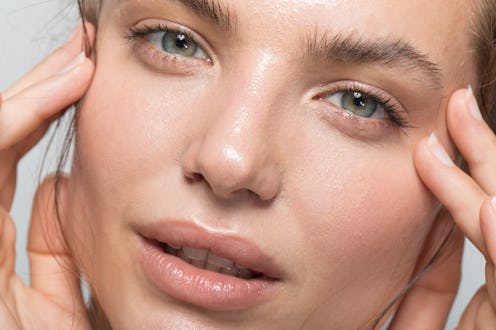(Treatments)
Jelly Roll Botox Gets Rid Of Under-Eye Wrinkles With Zero Downtime
But it’s not for everyone.

There’s a reason why Botox is a revered treatment for minimizing stubborn visible signs of aging. Even among the most needle shy folks, it remains a minimally invasive procedure that requires little prep, downtime, and aftercare, all while delivering smoother skin. Botox is currently FDA-approved for moderate to severe forehead lines, frown lines, and crow's feet, but some of the injectable’s off-label uses include the underarms (for sweating),the jaw (for TMJ), and the temples (for migraines). More recently, no thanks to the over two million views #JellyRollBotox has amassed on TikTok, the under eyes (or “jelly rolls”) are another area that have been added to the list.
What is a jelly roll, and how do you know if you have one? “The term refers to the wrinkles that form on your lower eyelid when the orbicularis oculi (the muscles that surrounds the eye) contracts and creates a small ‘roll’ appearance on the lower eyelid, specifically when smiling,” explains double board-certified dermatologist Dr. Jacquiline Hakim, M.D., of Divina Dermatology in Los Angeles. TikTok users credit jelly roll Botox for a reduction in said bunching, wider-looking eyes, and a more youthful appearance overall. But, as with all injectables, the treatment isn’t for everyone and there are some important factors to be aware of prior to getting jelly roll Botox.
Below, TZR tapped skin experts to learn all about the treatment, including how it works, its benefits, and the risks involved.
What Is Jelly Roll Botox?
The treatment gets its buzzy name from the shape of the wrinkles under the eyes. “Jelly roll Botox is considered an off-label advanced injection technique where a small amount of Botox is placed in the orbicularis oculi, directly into the area that is creating the jelly roll,” Hakim tells TZR. “The treatment works by relaxing the muscle from contracting, therefore preventing the jelly roll from forming and giving a smooth appearance under the eye.”
Typically, only one to five units per eye is all that’s needed to make an impact, but the amount of toxin used should be tailored to achieve different aesthetic outcomes, says Lisa Goodman, physician’s assistant and founder of GoodSkin Clinics. It’s also worth noting that while jelly roll Botox can be an effective treatment for those looking to improve bulging underneath their eyes, it’s not a suitable treatment for other under-eye conditions you may be facing like dark circles or bags.
The Benefits Of Jelly Roll Botox
First up, a lesson on the way the skin on the under eye ages. “Eyelid skin is the thinnest, most fragile skin on your body and prone to signs of aging, such as fine lines, wrinkles, and sun damage that can begin to appear in your mid to late 20s,” says Hakim. Jelly rolls occur as the skin underneath the eyes bunches up when the muscle in this area contracts against the lower eyelid. Some people have a stronger orbicularis oculi muscle than others, which can make their eyes appear smaller when smiling. Coupled with the fact that the skin under the eye area is particularly thin, jelly rolls has the potential of making fine lines and wrinkles underneath the eyes more prominent. Cue jelly roll Botox.
The main benefit of the buzzy treatment is that it relaxes the muscle that normally compresses the skin in this area. “In order for a jelly roll to show itself, the muscles under the eye have to contract,” says Dr. Hakim. “Botox works by relaxing the muscle it is injected into, and by relaxing the under eye muscle, the jelly roll can no longer form.” The treatment can also contribute to wider-looking eyes, especially when smiling. This is because when you relax the upward pull of the orbicularis oculi muscle that encircles the eye, it creates a rounder appearance, says Austin-based board-certified dermatologist Dr. Madeleine Gantz, M.D., of Westlake Dermatology in Austin, Texas.
What To Consider About Jelly Roll Botox
Jelly roll Botox isn’t a one-size-fits-all treatment and the under eyes aren’t a straightforward area to treat. “It's crucial to note that if not administered properly, Botox injections can potentially worsen bunching issues,” warns Goodman. “This is especially true for clients with pre-existing volume loss, as Botox can accentuate the appearance of hollowing or volume issues.” With repeated use, injecting Botox in this area can also enlarge the muscles underneath the eyes over time, causing it to resemble eye bags or herniated fat pads, adds Goodman. Finally, older patients with excessive tissue laxity are not candidates for jelly roll Botox due to the risk of ectropion, a condition where the skin on the eyelid hangs away from the eye. It also puts them at a higher risk of not being able to fully close their eyes, says Hakim.
Other risk factors include puffiness if over-injecting. “Lymphatic drainage underneath our eyes is dependent upon contraction of the orbicularis oculi muscle, and if it becomes too relaxed, it’s possible that the under eye area can appear puffy,” says Gantz. “Patients who already have swelling under their eyes when they wake up in the morning should probably avoid this treatment due to the risk of increased puffiness.” In some cases, jelly roll Botox can also lead to changes in your smile — because the eyes normally narrow when smiling, preventing this narrowing can result in an unnatural looking smile.
In all cases, you should consult with a qualified injector to determine whether or not you’re the best candidate for jelly roll Botox.